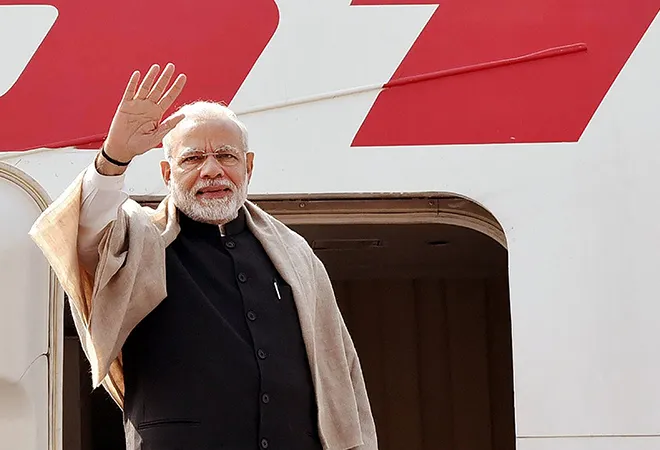Prime Minister Narendra Modi’s tri-nation trip to West Asia covering Palestine, UAE and Oman is the continuation of an extended outreach under his government to expand demographic, political and economic ties with India’s largest trade region. During this visit, Modi is set to become the first Indian Prime Minister to visit Palestine after becoming the first PM to visit Israel in July last year.
As many speculated whether the historic stance that India has been propagating for years over the Palestine cause would survive a nationalistic and largely Hindu narrative of the BJP government, even prior to his visit to Tel Aviv, New Delhi hosted Palestinian president Mahmoud Abbas, continuing the decades old institutionalised policy posture and staying distant from any drastic change in its approach.
What works in India’s favour here is the tight-rope balancing act it pulls off in the region, successfully dealing with the various power centres, religious and sectarian crevasses and economic interests without breaking any relationships.
The fact that Ramallah is aware and acceptable of India’s growing relations with Israel, and Tel Aviv knows of India’s long-standing stance on Palestine and support for a two state solution, and both Israel and Palestine accept India’s relations with each other emboldens its ‘non-aligned’ position in the region, perhaps the only diplomatic space in the world where the very idea and implementation of non-alignment still bears fruit in the current climate.
Beyond the usual historical caveats, it is not to undermine that the optics of Modi becoming the first Indian Prime Minister to visit Palestine are significant. With the baggage of the riots in Gujarat, a party image as that of being pro-Hindu nationalists, motor mouth party members and members of Parliament making statements such as “Muslims should not stay in India” in public and Gulf leaders not jumping ahead of the queue to congratulate him when he won the elections in 2014 to welcoming him in the region today with gusto has little to do with Modi itself, but the blessings of the economy he represents.
The turn observed by global economics over the past decade has not only put developing economies in Asia at the centre of the global growth story but also reshaped how countries in West Asia approached India.
The movement of oil consumption from the West to the East has played a pivotal role, with the likes of India, China, Japan and South Korea becoming the world’s largest oil importers to feed their fast moving economies. Out of these, India and China led the charge, with India importing a majority of its requirements from the region.
With Asian economies becoming majority oil buyers, West Asian economies increasingly depended on these sales to power their domestic economics as other Western markets moved swiftly to renewables or, in the case of the US, became energy self-sufficient thanks to its shale boom. This shift gave India an upper hand in negotiating larger political and trade deals, with long-standing sore points of cooperation such as counter-terrorism and labour rights becoming more favourable to Indian demands and requirements, which had been undercut by the Gulf capitals for a long time.
Both Oman and the UAE also present further opportunities for India to increase its trade base. The former is possibly the most stable country in the region, with no direct linkages to any conflict, a stable economy, relatively peaceful society managed by the region’s longest serving sultan, Qaboos Bin Said al Said, who’s ruled the nation since 1970. Modi will become the fifth Indian Prime Minister to visit Oman since the first visit by Rajiv Gandhi in 1985. The UAE already has robust relations with India that have only strengthened over the past few years. During his visit, which will be his second in this term alone, Modi will lay the foundation stone for Abu Dhabi’s first Hindu temple, a symbolic moment in an otherwise conservative region.
The West Asian outreach does not end with the visit to the Gulf, upon his arrival back from the tri-nation trip, India will be ready to host the president of Iran, Hassan Rouhani, whose country is embroiled in a bitter feud for regional supremacy with Saudi Arabia and other Gulf states.
To colour within the lines of diplomatic manoeuvring required for the region, while Iran remains bitter rivals with both Saudi Arabia and UAE, Oman, a Gulf Cooperation Council (GCC) member, has remained neutral in both the Yemen civil war (fought between Saudi backed Yemen government and Iran backed Houthi rebels) and the Qatar — Gulf crisis, which saw Riyadh install a trade embargo against Doha. In midst of this dynamic, India has equal leverage with all the players, and that allows New Delhi to facilitate Indian interests without dealing with the regional intricacies of West Asian politics.
This commentary originally appeared in News18.com.
The views expressed above belong to the author(s). ORF research and analyses now available on Telegram! Click here to access our curated content — blogs, longforms and interviews.




 PREV
PREV



